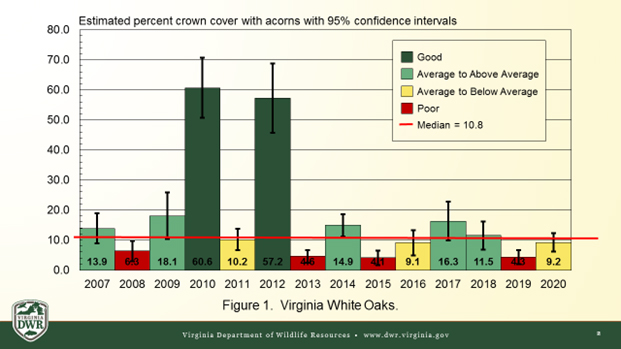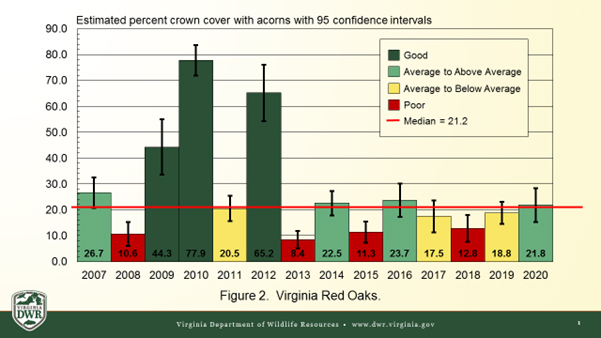
By Katie Martin, DWR Deer/Bear/Turkey Biologist
Photos by Lynda Richardson/DWR
More than 200,000 hunters will take to the woods this fall in search of deer, turkeys, and bears as well as a host of smaller game species. Hunters should know that acorns are a nutritious food providing protein, fat, and energy in the diets of 90 species of game and non-game animals in Virginia. Because acorns impact both wildlife and hunter success, the Department of Wildlife Resources (DWR) annually monitors acorn crops across the state.
There seem to be few things normal about 2020, but one of them is acorn production in Virginia! Our surveys revealed that both white and red oak acorn crops were close to the long-term median in 2020. A total of 31 survey sites were sampled across the Commonwealth in 2020 by DWR staff and numerous partner organizations and volunteers.

Sites throughout the mountains were extremely low for white oak, especially on high elevation north or east facing slopes. Better production was seen on southern slopes, particularly at low to medium elevations. The North Mountain region in particular has seen a significant decline in white oak production in the past three years. Throughout the Piedmont, white oak crops were boom or bust. Some sites were well above the long-term median while others were poor. The Tidewater region had above average white oak production on two out of three survey sites.
Red oak production was consistently above average in the mountains, but fell shy of our long-term median in the Southern Piedmont and Tidewater regions. In the mountain regions, red oak production ranged from good in the southern and central mountains to fair in the northern mountain counties. In the Piedmont, red oak acorn production was fair throughout the region, with the exception of poor production in the southern Piedmont. In the Tidewater, two out of the three routes were failures, but one route came in well above the survey average.

Readers should know that mast abundance ratings are intended to reflect regional averages, however mast crops are not uniform across a region. Acorn abundance can vary among local areas that are only 10-15 miles apart. Anecdotally, the acorn crop (particularly for white oak) appeared to be above average throughout certain areas of the state. Scouting will once again prove useful to Virginians going outdoors this fall with or without a weapon, to enjoy our wildlife and perhaps harvest a deer, bear, or wild turkey.
Acorns are a staple food for Virginia’s wildlife, providing important resources to meet the physical challenges of winter weather and reproduction in the following spring. Wildlife need to move less when acorns are abundant, making game harder to find and leaving some hunters to wonder if game populations are lower. Under these conditions, hunter success rates decline. Conversely, when acorn crops fail, game search forests and fields more often for other food sources, which makes game easier for hunters to find and may increase a hunter’s odds of success.


